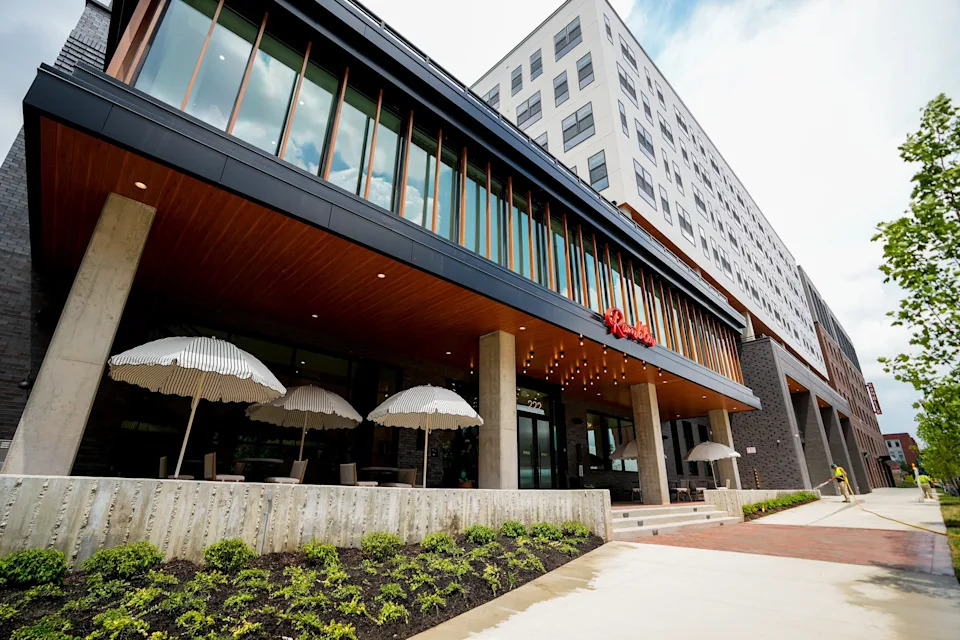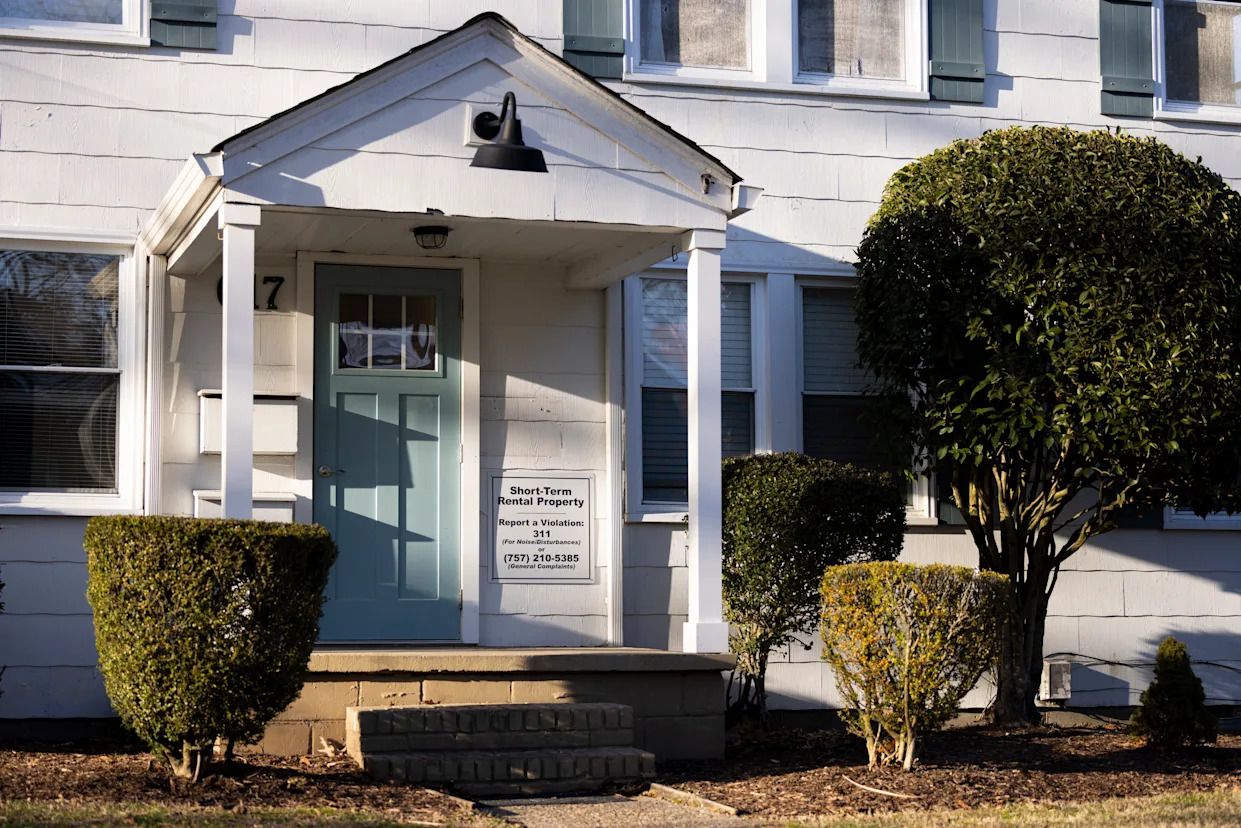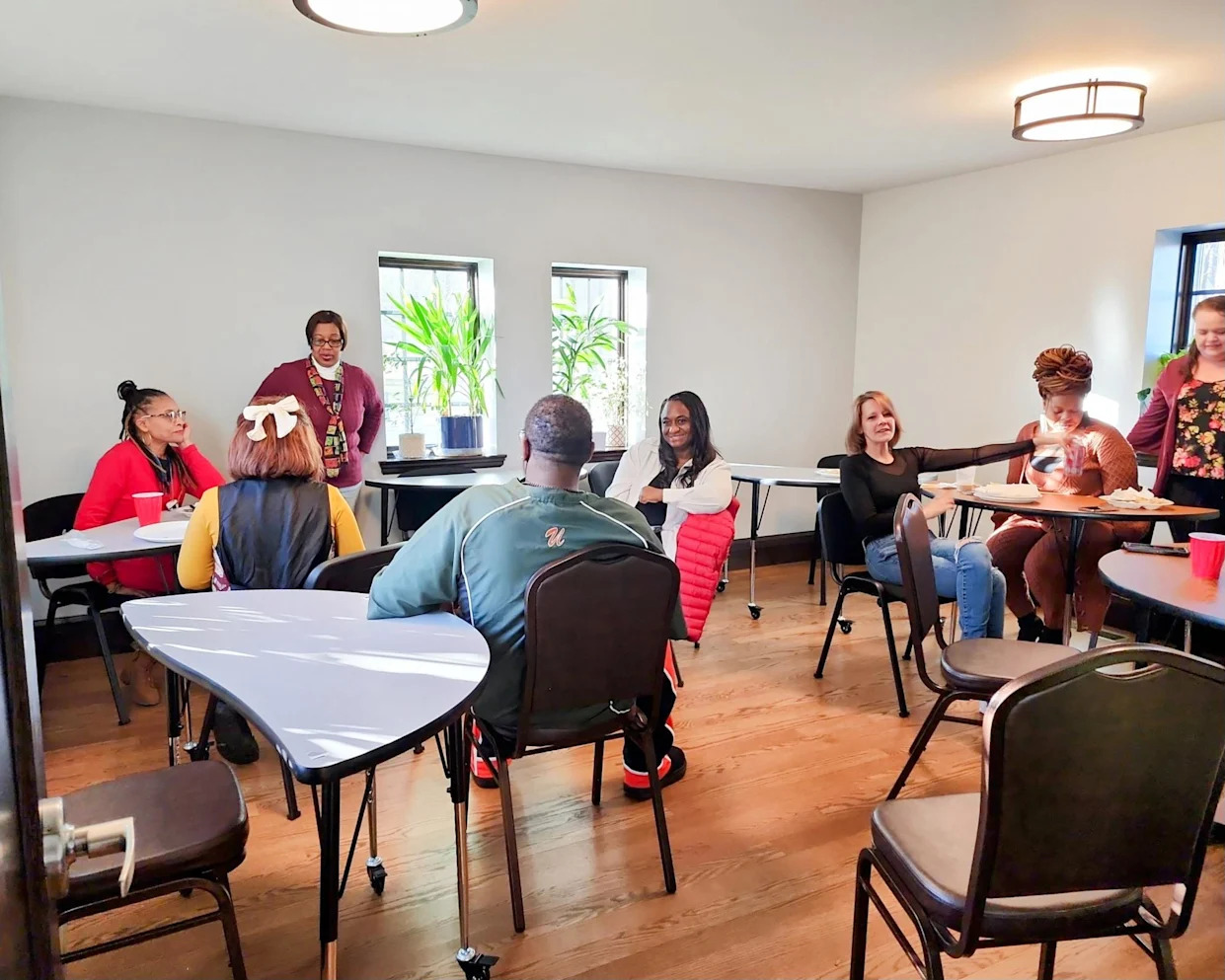While exploring off-campus housing options, August Tucker was confronted with two starkly different versions of student life.
A rising Ohio State University third-year student, Tucker could’ve spent $500 a month to share a modest, slightly weathered home with two roommates near South campus, a roughly 20-minute walk to class.
Or, he could’ve chosen a one-bedroom apartment with access to a rooftop pool and Jumbotron, sauna and yoga studio, in-house cafe and bar and a pet spa, all mere steps from campus.
The price for such luxury — an average of $2,100 a month. Other multi-tenant units cost less, with the cheapest, six-bedroom spaces averaging $1,225.
Unable to justify such an “off-putting” price tag, Tucker opted for the $500 option.
“Sure, these cheaper places are not great quality, but we’re gonna be more comfortable financially,” Tucker said. “It’s just frustrating; we’re all part-time, minimum-wage workers.”
Towering over the northwest edge of campus at 222 W. Lane Ave., Rambler is the newest University District luxury housing complex, but it is far from the first.
Over the past 20 years, upscale student high-rises like 8th and High, Wilson Place, Lumen on Ninth and now Rambler, which will open its doors to student renters for the first time July 31, have transformed the near-campus area, each boasting its own set of glamorous amenities and steep rents to match.
Though he wasn’t considering Rambler specifically, Tucker — who uses a cane to help with his mobility disability — was open to other luxury apartments for their physical accessibility features, like elevators and proximity to campus. But when he saw that even the cheapest options ran around $1,000 a month, Tucker said he began to see luxury student housing as not just inaccessible, but “predatory.”
Tucker isn’t the only student who feels this way. Based on feedback from users of the Columbus subreddit community, many feel frustrated by the expensive nature of these luxury complexes and a perceived lack of student housing that is both affordable and safe. Any yet, some of these high-rise developments say they have occupancy rates near or at 100%.
The Dispatch spoke with multiple Columbus housing experts to better understand why a commodity that is so seemingly unpopular has continued to thrive in the University District, and what lasting effects these properties may have on the area. Though many validated students’ concerns about affordability, some think the bigger luxury housing picture is more complicated.
What’s the deal with luxury housing, and why does the University District have so much of it?
Most assume the high rent costs associated with luxury housing are due to the properties’ lavish amenities. But Erin Prosser, Columbus’ deputy director of housing strategies, said that’s not what the cost is really about.
It actually comes down to construction, she said.
Because the cost of construction is so high across all types of housing, especially in a high-demand area like the University District, Prosser said rent prices would barely budge if all amenities were removed.

High building costs force developers to charge higher rents, in turn pushing them to add luxury amenities to justify the price, Prosser said.
“It is very difficult to build any housing that would not be considered luxury," Prosser said, referring to the high rents developments have to command regardless of their aesthetic.
Amid a nationwide, decade-long housing shortage, Columbus saw immense population growth despite little-to-no building, Prosser said. That means most student housing options either predate the Great Recession or are brand-new.
In theory, as the city continues to restore its housing stock, the costs of housing — luxury included — should drop in seven to nine years, Prosser said.
But for Tucker, this doesn’t provide much reassurance.
“For the majority of current students who need housing, they’re not gonna see that,” Tucker said. “That’s gonna be multiple graduating classes from now. That’s tens of thousands of students who have to suffer.”
Real estate market analyst Rob Vogt has another theory.
Contrary to Prosser, Vogt said he thinks the University District’s luxury student housing market has already been overbuilt, and the ripple effects of that — namely the decline of luxury rental rates — will begin to take effect in closer to two years, not seven.
One measure of an overbuilt market is vacancies, Vogt said. Whether it’s “One month free rent” or “Get a $1,200 gift card if you sign before this date,” Vogt has observed rent concession offers at various student high-rises, which he said is usually the first indication that a development is having issues getting renters.
Rambler began leasing in April 2024. As of July 24, a spokesperson for Rambler said it was 92% pre-leased.
Is all housing good housing?
There are no universal definitions of “affordable” and “luxury” with regard to housing. But as a general rule of thumb, executive director of the Affordable Housing Alliance of Central Ohio Carlie Boos said no one should contribute more than one-third of their income to housing.
“It’s a community’s obligation to really understand who its people are and what their housing needs are, and build for that reality," Boos said. "If you have individuals who are affluent, who want luxury housing, absolutely meet that piece of the community. But understand that it is just a segment, and you have to meet the other pieces too.”
Unfortunately, Prosser said the market needs this housing stock one way or another, even if the “luxury” label that inherently comes with it isn’t what most students are looking for.
Boos agreed that high construction costs are driving rents upward but said it's always possible to be intentional about affordability, such as by building starter homes and starter apartments. And across the University District and all of central Ohio, Boos said there just aren’t enough.
From Boos’ perspective, there is truth in the idea that all housing is good housing, especially given the shortage Columbus is experiencing as its population grows. But the general lack of affordable options in the University District may leave a lasting impression on the demographic makeup of the area, she said.
“I don’t think that anybody looks at a ritzy building and says, ‘I’m not gonna come because that’s here,’” Boos said. “They say, ‘I’m not gonna come because there’s nowhere for me.’ That’s a very different dynamic.”
Inside the minds of luxury developers: You get what you pay for
Before coming to Columbus, Jonathan Reyes — student housing president for LV Collective, the Austin, Texas-based developer that owns Rambler — said the company met with the mayor, City Council and student focus groups to learn more about the University District’s specific housing needs.
From there, Rambler, complete with 379 units and 889 beds, was born.
LV Collective is constantly thinking about student concerns regarding affordability, Reyes said, adding that’s why Rambler placed greater emphasis on the generally more affordable, larger units.
Reyes said no students have complained about Rambler’s rent rates, which he attributes in part to LV Collective accurately assessing what the University District community was “willing to bear” and delivering a product that reflects that cost.
“As you can tell by 92% pre-lease on a rendering, I think we kind of matched that perfectly,” Reyes said.
Jared Schiff — president at The Schiff Real Estate Company, which owns luxury apartment complex Wilson Place at 15 E. Lane Ave. — said he understands students’ complaints about affordability, but doesn’t agree with them. With an average cost of $1,375 per bed, Schiff said he knows Wilson Place may not be accessible to everyone but ultimately, “the costs are what they are.”
“You can wear a Marc Jacobs purse, or you can wear a Louis Vuitton purse,” Schiff said. “You can make the same argument about housing. It comes down to what you can afford. I wish everybody could afford to be in the safest property or the most luxurious property.”
Schiff said Wilson Place has been 100% leased every year with no vacancies since it opened in 2018, which he mostly credits to being a local developer and family-owned business.
Based on his experience surveying thousands of apartments nationwide as managing partner at Columbus-based national real estate research firm Vogt Strategic Insights, Vogt said he is skeptical of high pre-lease rates like those of Rambler and Wilson Place.
"Developers are probably better liars than anybody out there," Vogt said. "I would be very, very surprised at those numbers."
Both Rambler and Wilson Place have offered rent concessions this summer. When asked whether this is an indicator of vacancies within the properties, Reyes and Schiff each said no.
Rambler, Reyes said, has offered financial incentives to offset the inherent risk that comes with signing a lease for a property that’s still being constructed.
Schiff said Wilson Place has had to offer discounts and gift cards only because “everyone else is doing it.”
The future of Ohio State student housing: Where do we go from here?
Though most experts believe rent rates will drop eventually, they also said Columbus has a ways to go with affordable housing.
Prosser said the city is “deploying every tool in the toolbox” to help make it less expensive to build housing.
One such tool is Zone In Columbus, a city initiative that places fewer building requirements on developers so more housing can get built more quickly, while also incentivizing for developers to create more affordable units, she said.
It was the updated zoning code under Zone In that made possible Georgia-based Landmark Properties’ proposal for a 16-story high-rise at Lane Avenue and High Street.
Prosser also mentioned Mayor Andrew Ginther’s $1.9 billion bond package proposal, which includes $500 million in public subsidy investments that would be dedicated to affordable housing.
Boos agreed that these city efforts are great, but ultimately, “we have more work to do.”
“We have these really talented people who could go on to cure cancer or travel to Mars — they’ve got the skills, and they just need the education to do that,” Boos said.
“But instead, we’re seeing young people drop out of education because they can’t afford the housing to go with it. That’s really concerning, not just for them and their individual path to economic stability, but for us as a community who wants the kind of future that they can help create.”
Rates at Rambler
The following are average rent costs at University District luxury housing development Rambler, based on size of the apartment.
Studio (71 units) - $1,901
1 bed (88 units) - $2,155
2 bed (184 units) - $1,599
3 bed (57 units) - $1,462
4 bed (280 units) - $1,294
5 bed (125 units) - $1,239
6 bed (84 units) - $1,225
All units (889) - $1,487
Reporter Emma Wozniak can be reached at [email protected], or @emma_wozniak_ on X, formerly known as Twitter.
This article originally appeared on The Columbus Dispatch: Columbus University District's luxury student housing market boom








Comments